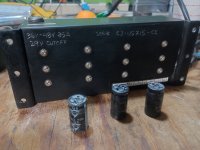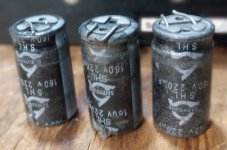Chalo
100 TW
So... the other day the funky old four-wire throttle that came with my old Crystalyte 5305 and 35A controller (bought direct from Crystalyte in China in 2003 or 2004) soiled its trousers, and the bike stopped working suddenly, without warning. I cut the controller loose from my cargo bike so I could take it to the pedicab shop to change out the throttle plug for a more usual three wire JST-SM plug. I bench tested all the parts together and everything worked just as before, minus the useless power-on indicator and red/green LED SOC indicator that were in the old throttle.
Later, when I was reassembling the bike and deleting all the old derelict wiring left over from earlier iterations, my buddy Dave picked up the controller and noticed it was rattling, like it had a foreign object closed up inside. So I opened it up for a look. To say I was surprised at what I found would be a strong understatement.
A big ole electrolytic capacitor (160V 220μF) fell out of the controller. Followed by another. And then another.

(I scratched the data from the controller's original paper labels into the case as the paper labels began to deteriorate.)
The caps had been floating around in there for some time, from the looks of them. Not only were the leads all smashed flat against the tops of the canisters, but the wrappers and unprotected free ends were textured from getting tumbled around in there for who knows how long.


Thing is, this controller never stopped working, never misbehaved at all. The only think I ever did to fix it over the almost 20 years I've had it was to replace crusty phase bullets, battery plugs, and JST plug for the Hall wires. Plus the throttle plug, just now. It still works just like before.
I love it! It just chugs along doing the thing it has always done, after jettisoning some seemingly important electronic components.
I intend to keep using it until it stops working right. I don't want to take it apart for a postmortem until it actually dies. Why mess with a good thing?
I guess I wonder this, though: if the big capacitors were put in there for a reason, why does the controller seem to function perfectly without them? What could be the drawback to rolling this thing without them?
Anyway, I reckoned I had to share this weird good luck with somebody else who could appreciate it, other than my buddy Dave.
Later, when I was reassembling the bike and deleting all the old derelict wiring left over from earlier iterations, my buddy Dave picked up the controller and noticed it was rattling, like it had a foreign object closed up inside. So I opened it up for a look. To say I was surprised at what I found would be a strong understatement.
A big ole electrolytic capacitor (160V 220μF) fell out of the controller. Followed by another. And then another.

(I scratched the data from the controller's original paper labels into the case as the paper labels began to deteriorate.)
The caps had been floating around in there for some time, from the looks of them. Not only were the leads all smashed flat against the tops of the canisters, but the wrappers and unprotected free ends were textured from getting tumbled around in there for who knows how long.


Thing is, this controller never stopped working, never misbehaved at all. The only think I ever did to fix it over the almost 20 years I've had it was to replace crusty phase bullets, battery plugs, and JST plug for the Hall wires. Plus the throttle plug, just now. It still works just like before.
I love it! It just chugs along doing the thing it has always done, after jettisoning some seemingly important electronic components.
I intend to keep using it until it stops working right. I don't want to take it apart for a postmortem until it actually dies. Why mess with a good thing?
I guess I wonder this, though: if the big capacitors were put in there for a reason, why does the controller seem to function perfectly without them? What could be the drawback to rolling this thing without them?
Anyway, I reckoned I had to share this weird good luck with somebody else who could appreciate it, other than my buddy Dave.

